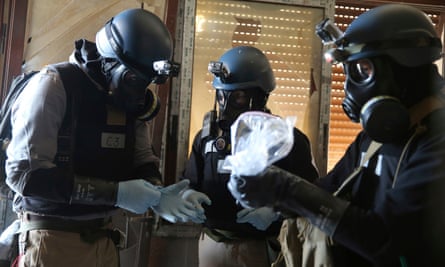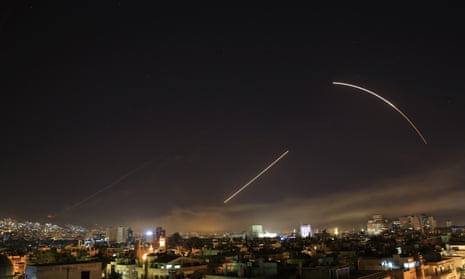Did Syria promise to abandon its chemical weapons stockpile?
Yes. On 21 August 2013, a large sarin gas attack occurred in the Damascus suburb of Ghouta, taking the UK parliament and the then US president, Barack Obama, to the brink of agreeing airstrikes against Syria as a punishment.
At a press conference on 9 September the then US secretary of state, John Kerry, in a throwaway remark said the Assad regime could avert a strike of it turned over its chemical weapons without delay. He then received a phone call from the Russian foreign minister, Sergei Lavrov, saying a deal on those lines was possible. In great haste, three days later Syria agreed to join the 1997 Chemical Weapons Convention.
How were the declared weapons destroyed?
A special joint mission of the Organisation for the Prohibition of Chemical Weapons and the United Nations (OPCW-UN) was established, charged with disposing of Syria’s entire chemical weapons stockpile. It was widely seen as the largest stockpile in the world and had been in development since the 70s.
The bulk of the chemical stock – mustard gas, sarin and VX – were
destroyed at sea using two-field deployable hydrolysis systems. Avril Haines, Obama’s national security adviser, said 1,300 tonnes of declared chemical weapons were destroyed.
The OPCW won the Nobel peace prize in 2013 for its work, and in September 2014 the joint mission was folded, declaring that 96% of Syria’s declared stockpile, including the most dangerous chemicals had been destroyed. Preparation was under way to destroy the remaining 12 production facilities, a job handed to the OPCW. In January 2016 the OPCW formally said all declared Syrian chemical weapons had been destroyed.

Were all Syria’s chemical weapons destroyed?
No. The OPCW weapons inspectors could only authenticate
that declared chemical weapons had been destroyed, even though there were suspicions in the west that Syria had hidden as much as 10% of its stockpile. By January 2016, the OPCW admitted it could not explain inconsistencies in the Syrian declaration. Some of the most crude industry-based chlorine gases do not require great sophistication to develop. Chlorine was never part of the deal, since it had legitimate industrial uses. Syria clearly retained a capacity and willingness to replenish its stockpile.
TimelineThe Syrian war
Show
Unprecedented protests demand civil liberties and the release of political prisoners after four decades of repressive rule by the Assad family. The regime represses demonstrations in Damascus and the southern city of Deraa but protests continue.
Defecting army colonel Riad al-Asaad sets up the Turkey-based rebel Free Syrian Army. Islamist groups join the revolt.
Regime forces take control of the rebel stronghold in Homs after a month of bombardment. Other bloody operations are carried out, notably in the central city of Hama, after massive anti-regime protests.
More than 1,400 people die in a chemical weapon attack on rebel-held districts near Damascus.
The US and Assad ally Russia agree a plan to eliminate Syria's chemical weapons, averting punitive US strikes against the regime.
Hostilities between jihadists and rebel groups turn into an open war in the north. The group that will become known as Islamic State takes Raqqa – the first provincial capital to fall out of regime control – from rebel forces.
A US-led coalition launches airstrikes against Isis in Syria. The strikes benefit Kurdish groups, which since 2013 have run autonomous administrations in Kurdish-majority areas.
Russia launches airstrikes in support of Assad's troops, who are on the back foot. Russian firepower helps turn the tables for the regime, which begins to retake rebel-held territory.
The regime retakes Syria's second city, Aleppo.
Russia and Iran, as backers of the Syrian regime, and Turkey, a supporter of the rebels, organise talks in Kazakhstan, between representatives of both sides. The process leads to the creation of four "de-escalation zones".
A sarin gas attack on the rebel-held town of Khan Sheikhun kills more than 80 people, prompting Washington to attack a regime airbase.
Further complicating an already drawn-out conflict, Turkey launches an operation against the Kurdish People's Protection Units which, with US support, played a key role in beating back Isis.
Regime launches a ferocious assault on the remaining rebel-held enclave near Damascus, eastern Ghouta. In under four weeks, the Russian-backed onslaught kills more than 1,200 civilians.
US president Donald Trump surprises advisors and allies alike by declaring victory over the Islamic State and promising to withdraw US troops from the conflict.
The Syrian Democratic Forces (SDF) announce that they have driven Isis out of their final stronghold of Baghuz. At least 11,000 SDF fighters, a Kurdish-led militia which includes Arab, Syriac and Turkmen units, have died in the four-year military campaign against the group in Syria.
Britain and France agree to deploy additional special forces in Syria to allow the US to withdraw its ground troops from the fight against remaining Isis forces in the country.
Rebels withdraw from Khan Sheikhun in north-west Syria, clearing the way for pro-government forces to enter the town – a key moment in the war for Idlib province, the country’s last major rebel stronghold.
How did the UN and OPCW respond to continuing evidence of chemical weapons attacks?
In March 2015 the UN passed a resolution, in the wake of a succession of OPCW fact-finding reports, that the UN would take action against any group believed to have chemical weapons under article V11 of the UN Charter. But the OPCW did not have the power to attribute culpability for chemical weapons attacks.
In 2015 the UN collectively agreed through resolution 2235 to set up a joint UN-OPCW joint investigatory mechanism (JIM) to address this gap. With an initial one-year mandate, its goal was to attribute responsibility for any chemical attack identified by an OPCW fact-finding mission. The aim, in the words of the US envoy to the UN, Samantha Power, was “to point the finger of blame”.
Did the JIM succeed?
The JIM panel chose nine cases initially to investigate out of 23, which had already been confirmed with the upmost confidence by the fact-finding missions. In its first reports in August 2016 it implicated both Islamic State and Syrian air force in specific attacks. A further report in October 2016 again implicated the Syrian air force, leading to calls for individuals to be referred to the international criminal court.
Overall, it produced seven reports and assigned responsibility to the Syrian government for four chemical weapons attacks (Khan Sheikhun on 4 April 2017, Qmenas and Sarmin on 16 March 2015, and Talmenes on 21 April 2014) and to Isis for two (Umm Hawsh on 15-16 September 2016 and Marea on 21 August 2015).
In 2016, Russia started to challenge the legitimacy of the JIM process, saying its inquiries were both disproportionately focused on the regime and its methods flawed. Despite complaints, the UN security council agreed in November 2016 to renew the JIM mandate for a further year.

Did JIM findings lead to any accountability?
No. Russia vetoed any referral of Syria to the ICC, and in February 2017 vetoed a resolution that would have given UN power to impose sanctions on perpetrators of any chemical weapons attack.
How did the JIM collapse ?
The disagreement over JIM’s procedures came to a head after the investigators in October 2017 found that the Syrian government was responsible for the Khan Sheikhun attack of 4 April 2017, an attack that led to a US unilateral strike. Russia criticised the finding saying the sources were questionable, the chain of custody in doubt and no on-site inspection had taken place, even though security guarantees had been given by the Russians.
In November 2017 Russia and the US clashed at the UN, submitting competing drafts on the terms on which the JIM mandate could be renewed. The Russian draft demanded the Khan Sheikhun inquiry be reopened, challenged the impartiality of OPCW technical staff and said any JIM inquiry must look wider than evidence provided by the OPCW fact finding team.
The rival US draft re-establishing the JIM was vetoed by Russia on
16 November, as was a Japanese compromise designed to keep the JIM alive for a further month pending a compromise being negotiated.
The JIM, the world’s only method of ensuring accountability for the use of chemical weapons in Syria, was abolished, and a dangerous signal of impunity was sent out.
What has happened since then?
In response to the November impasse France sent up an ad hoc group of nations committed to accountability for the use of chemical weapons, but, outside the UN, it has no powers. At the UN itself, throughout February and March, the US worked quietly to see how it could revive the concept of the JIM, and accountability. Russia also prepared a draft on 26 January.
These discussions could no longer be confined to private diplomacy once news broke of the chemical weapons attack in the Syrian town of Douma on 7 April. At the UN security council on 10 April, the US and Russia again clashed over how to revive the concept of an investigatory mechanism. The US envoy, Nikki Hayley, insisted the JIM had to be independent and impartial, but the Russian envoy, Vassily Nebenzia, said the JIM had become a puppet of anti-Damascus forces, and had covered itself in shame when it issued a guilty charge against a sovereign state without credible evidence. The US and Russia tabled two draft resolutions that had been in private discussion since January.
The Russian draft resolution required all investigations to include changes to the geographic spread of OPCW inspectors, mandatory on-site inspection, and any findings would be subject to a collective endorsement by the UN security council – which would provide Russia with a veto on any finding. It also said any finding had to be proven beyond reasonable doubt, a new higher quasi-judicial standard.
Both the US and Russian resolutions fell. Russia vetoed the US draft, the 12th time it has wielded its veto on Syria. The chasm over chemical weapons grows wider, with as yet incalculable consequences.








